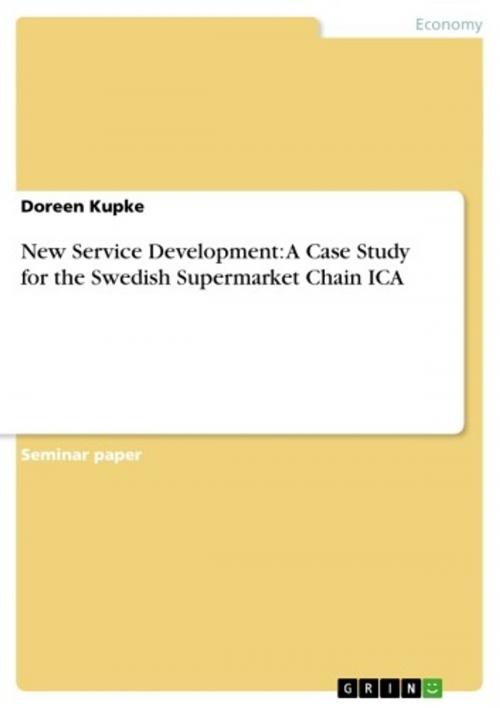New Service Development: A Case Study for the Swedish Supermarket Chain ICA
Business & Finance, Marketing & Sales| Author: | Doreen Kupke | ISBN: | 9783656383222 |
| Publisher: | GRIN Verlag | Publication: | March 5, 2013 |
| Imprint: | GRIN Verlag | Language: | English |
| Author: | Doreen Kupke |
| ISBN: | 9783656383222 |
| Publisher: | GRIN Verlag |
| Publication: | March 5, 2013 |
| Imprint: | GRIN Verlag |
| Language: | English |
Seminar paper from the year 2012 in the subject Business economics - Marketing, Corporate Communication, CRM, Market Research, Social Media, grade: 2,3, Karlstad University, course: New Service Development, language: English, abstract: Table of Content (I) List of Figures and Tables2 1. Introduction3 1.1 Background and Purpose3 1.2 Aim3 1.3 Methodology3 2. Authors Process Steps4 3. Description of the Concept Finding for ICA5 3.1 Service Maintenance6 3.2 Improve Service Performance7 3.3 Service Innovation8 3.4 Description of the Innovations used for a New ICA Concept9 3.4.1 Improvement of the Package9 3.4.2 Customer Roles and Interaction9 4. Strategy Description for ICA11 4.1 The Product Journey11 4.2 Customer Involvement12 4.3 Summarization of the Strategy14 5. Conclusion15 (II) References16 The challenge which many companies have to face nowadays is to stay competitive at the market. According to Gustafsson and Johnson (2003), New Service Development can be used to achieve a competitive advantage and compete through services. Thereby, the term of New Service Development (abbreviated as NSD) gets into focus of companies to emphasize their own offerings of those from their competitors. The question remains what steps are involved in the process of NSD and how companies can achieve a successful service development. One major influence within NSD is the customer and their knowledge provided for firms. Customer involvement in the different service development steps of a company belongs nowadays to the day-to-day business of many companies and provide customer focused products remains a crucial part of this. (Alam, 2006) Within this report the change process of a supermarket (ICA) from a normal good-dominant grocery store to a more service-dominant business is lined out. The dy-namic process of NSD is described via own product experiences combined with NSD theories. The last step is the strategy development for ICA. The strategy aims to achieve a competitive advantage and ensure the company growth.
Seminar paper from the year 2012 in the subject Business economics - Marketing, Corporate Communication, CRM, Market Research, Social Media, grade: 2,3, Karlstad University, course: New Service Development, language: English, abstract: Table of Content (I) List of Figures and Tables2 1. Introduction3 1.1 Background and Purpose3 1.2 Aim3 1.3 Methodology3 2. Authors Process Steps4 3. Description of the Concept Finding for ICA5 3.1 Service Maintenance6 3.2 Improve Service Performance7 3.3 Service Innovation8 3.4 Description of the Innovations used for a New ICA Concept9 3.4.1 Improvement of the Package9 3.4.2 Customer Roles and Interaction9 4. Strategy Description for ICA11 4.1 The Product Journey11 4.2 Customer Involvement12 4.3 Summarization of the Strategy14 5. Conclusion15 (II) References16 The challenge which many companies have to face nowadays is to stay competitive at the market. According to Gustafsson and Johnson (2003), New Service Development can be used to achieve a competitive advantage and compete through services. Thereby, the term of New Service Development (abbreviated as NSD) gets into focus of companies to emphasize their own offerings of those from their competitors. The question remains what steps are involved in the process of NSD and how companies can achieve a successful service development. One major influence within NSD is the customer and their knowledge provided for firms. Customer involvement in the different service development steps of a company belongs nowadays to the day-to-day business of many companies and provide customer focused products remains a crucial part of this. (Alam, 2006) Within this report the change process of a supermarket (ICA) from a normal good-dominant grocery store to a more service-dominant business is lined out. The dy-namic process of NSD is described via own product experiences combined with NSD theories. The last step is the strategy development for ICA. The strategy aims to achieve a competitive advantage and ensure the company growth.















